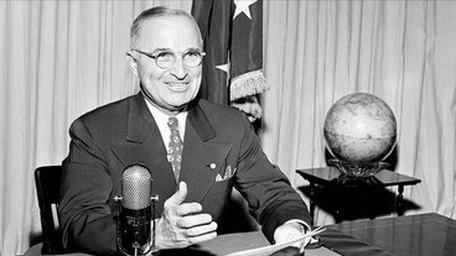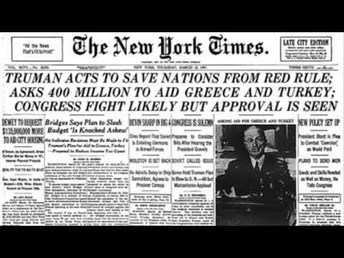Containment & The Truman Doctrine
By the end of 1946 serious differences had emerged between the West and the Soviet Union regarding the fate of postwar Germany and Eastern Europe. In the eyes of many Americans, members of the Truman administration as well as average citizens, the Soviets seemed bent on dominating much of the European continent in a manner reminiscent of that of Nazi Germany.
The main question for U.S. policymakers was how to respond to Soviet aggression. With the recent experience of the late 1930s very much in mind, President Truman concluded that the Soviet Union was behaving like a bully and that the best way of dealing with a bully was to stand up to him. While there were some within the administration-namely Secretary of Commerce Henry Wallace—who dissented from this opinion, calling for greater understanding of the USSR's need for security, most policy makers found persuasive the arguments of White House Counsel Clark Clifford. In September 1946 Clifford sent Truman a memo in which he traced the history of U.S.-Soviet relations and offered a set of recommendations for foreign policy. His conclusion was that the Soviet leadership was convinced of the inevitability of war between the capitalist and the communist world, and as long as this was the case there was little hope for reaching mutual understanding with them. Instead, the United States had to "be prepared, while scrupulously avoiding any act which would be an excuse for the Soviets to begin a war, to resist vigorously and successfully any efforts of the U.S.S.R. to expand into areas vital to American security."
This strategy, however, meant a radical new direction for U.S. foreign policy. The United States did not have a long tradition of direct intervention in European and Asian affairs. President Truman sought to prepare Americans for their new international role by announcing the so-called "Truman Doctrine" in 1947. The United States, he told Congress, should take responsibility for defending "free peoples" throughout the world from communist aggression. This policy first took concrete form as a substantial package of economic and military aid to Greece and Turkey, which were thought to be threatened by Soviet expansionist tendencies.
However, Truman and his advisers believed communism to be more than merely a military threat. Postwar Europe remained economically devastated in 1947, leading to fears that communist parties might succeed in taking power through legal means in places like France, Germany, and Italy. In order to assist in Europe's recovery, the administration proposed the Marshall Plan—named for Secretary of State George C. Marshall, who introduced the concept in a June 1947 speech at Harvard University. The program was officially launched in 1948, and by the end of 1951 more than 13 billion dollars had been sent to Europe. While some economic historians have questioned how effective it was in actually promoting economic recovery, it certainly generated considerable good will toward the United States among the nations of Europe.
By the end of 1947 it was clear that the United States was becoming involved in European affairs to an unprecedented extent. The strategy by this time had a name, which first appeared in an influential journal article by George Kennan. According to Kennan, a prominent State Department official who had spent years living in the Soviet Union, any aggressive moves on Stalin's part needed to be met with a policy of "containment"—firm resistance in the hope that, if communism were prevented from spreading, the Soviet system would ultimately change from within.
Not everyone saw the adoption of "containment" as a positive development. Some Republicans, like Senator Robert A. Taft of Ohio, argued that the United States could become overextended by committing itself to the security of other countries. Columnist Walter Lippman, on the other hand, believed that containment would ultimately result in a "cold war" between the United States and the Soviet Union. Of course, this is precisely the term that would come to apply to the entire period between 1945 and 1989.
-From Edsitement!
Discussion Questions
1. Why did Clark Clifford believe there was little hope for reaching a peaceful or mutual understanding with the Soviets?
2. Why was the Truman Doctrine a radiacl new direction for U.S. foreign policy?
3. What about Europe (depicted in the pictures below) concerned Truman and his advisers that it was possible that communism could spread through legal and peaceful means (that is without military action from the Soviets)?
4. How did Truman hope to prevent the spread of communism in Europe through legal means?
5. What were some of the concerns of critics of the containment strategy?
By the end of 1946 serious differences had emerged between the West and the Soviet Union regarding the fate of postwar Germany and Eastern Europe. In the eyes of many Americans, members of the Truman administration as well as average citizens, the Soviets seemed bent on dominating much of the European continent in a manner reminiscent of that of Nazi Germany.
The main question for U.S. policymakers was how to respond to Soviet aggression. With the recent experience of the late 1930s very much in mind, President Truman concluded that the Soviet Union was behaving like a bully and that the best way of dealing with a bully was to stand up to him. While there were some within the administration-namely Secretary of Commerce Henry Wallace—who dissented from this opinion, calling for greater understanding of the USSR's need for security, most policy makers found persuasive the arguments of White House Counsel Clark Clifford. In September 1946 Clifford sent Truman a memo in which he traced the history of U.S.-Soviet relations and offered a set of recommendations for foreign policy. His conclusion was that the Soviet leadership was convinced of the inevitability of war between the capitalist and the communist world, and as long as this was the case there was little hope for reaching mutual understanding with them. Instead, the United States had to "be prepared, while scrupulously avoiding any act which would be an excuse for the Soviets to begin a war, to resist vigorously and successfully any efforts of the U.S.S.R. to expand into areas vital to American security."
This strategy, however, meant a radical new direction for U.S. foreign policy. The United States did not have a long tradition of direct intervention in European and Asian affairs. President Truman sought to prepare Americans for their new international role by announcing the so-called "Truman Doctrine" in 1947. The United States, he told Congress, should take responsibility for defending "free peoples" throughout the world from communist aggression. This policy first took concrete form as a substantial package of economic and military aid to Greece and Turkey, which were thought to be threatened by Soviet expansionist tendencies.
However, Truman and his advisers believed communism to be more than merely a military threat. Postwar Europe remained economically devastated in 1947, leading to fears that communist parties might succeed in taking power through legal means in places like France, Germany, and Italy. In order to assist in Europe's recovery, the administration proposed the Marshall Plan—named for Secretary of State George C. Marshall, who introduced the concept in a June 1947 speech at Harvard University. The program was officially launched in 1948, and by the end of 1951 more than 13 billion dollars had been sent to Europe. While some economic historians have questioned how effective it was in actually promoting economic recovery, it certainly generated considerable good will toward the United States among the nations of Europe.
By the end of 1947 it was clear that the United States was becoming involved in European affairs to an unprecedented extent. The strategy by this time had a name, which first appeared in an influential journal article by George Kennan. According to Kennan, a prominent State Department official who had spent years living in the Soviet Union, any aggressive moves on Stalin's part needed to be met with a policy of "containment"—firm resistance in the hope that, if communism were prevented from spreading, the Soviet system would ultimately change from within.
Not everyone saw the adoption of "containment" as a positive development. Some Republicans, like Senator Robert A. Taft of Ohio, argued that the United States could become overextended by committing itself to the security of other countries. Columnist Walter Lippman, on the other hand, believed that containment would ultimately result in a "cold war" between the United States and the Soviet Union. Of course, this is precisely the term that would come to apply to the entire period between 1945 and 1989.
-From Edsitement!
Discussion Questions
1. Why did Clark Clifford believe there was little hope for reaching a peaceful or mutual understanding with the Soviets?
2. Why was the Truman Doctrine a radiacl new direction for U.S. foreign policy?
3. What about Europe (depicted in the pictures below) concerned Truman and his advisers that it was possible that communism could spread through legal and peaceful means (that is without military action from the Soviets)?
4. How did Truman hope to prevent the spread of communism in Europe through legal means?
5. What were some of the concerns of critics of the containment strategy?

